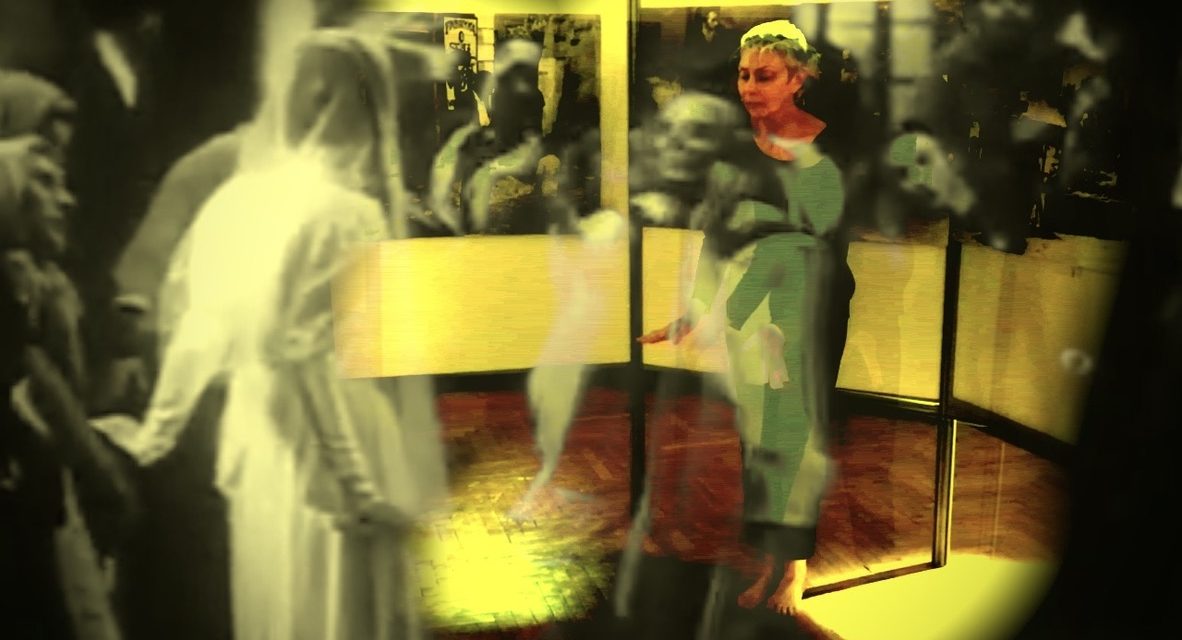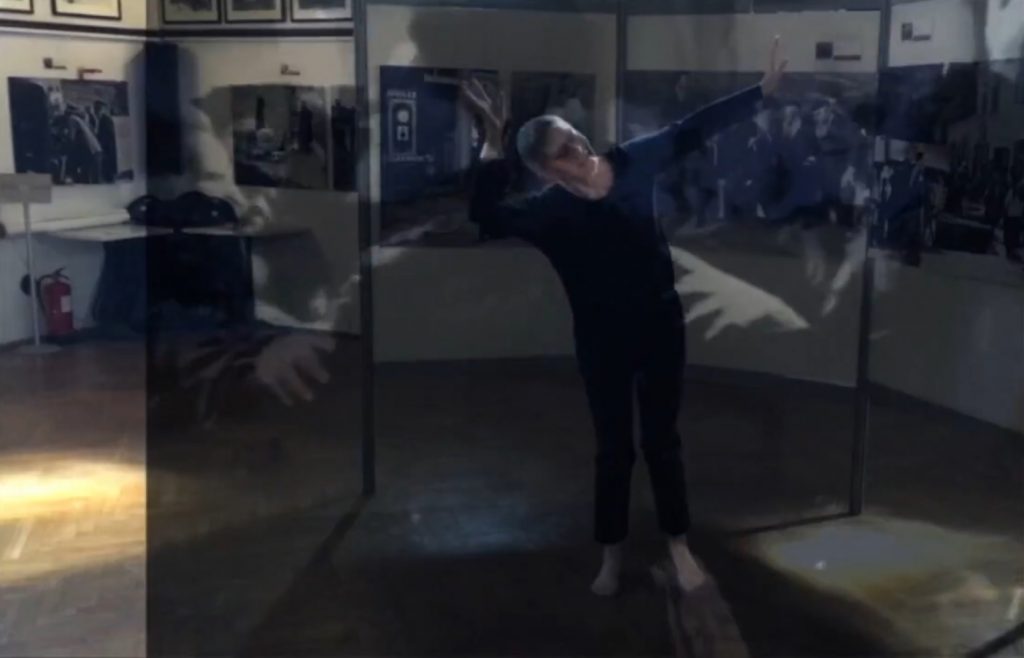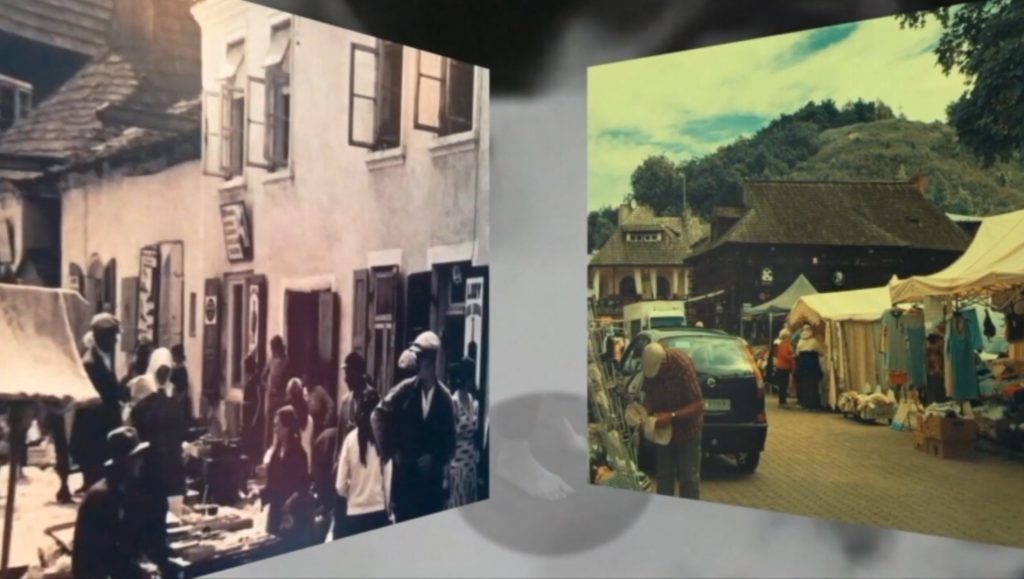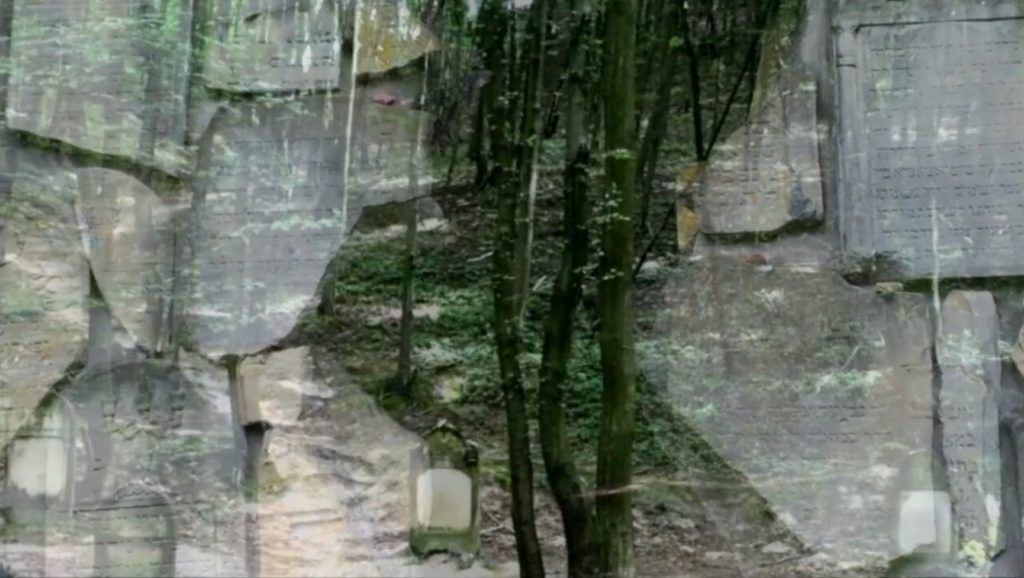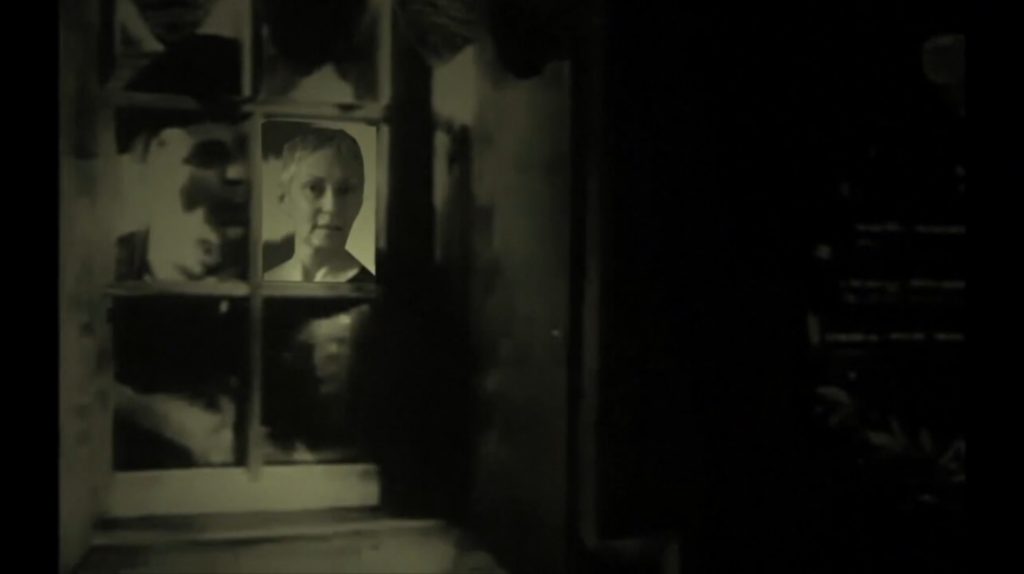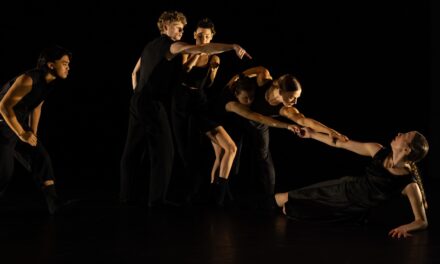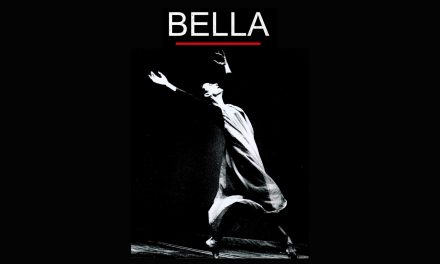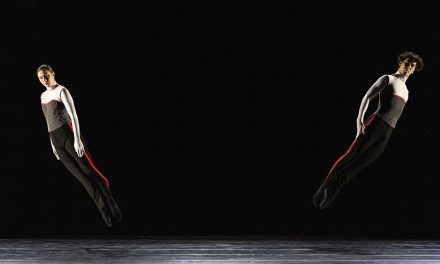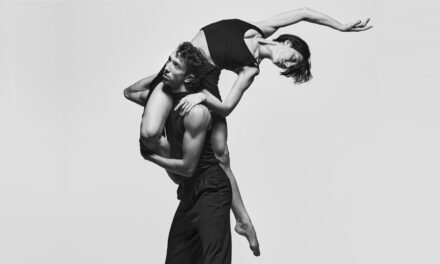Dybbuk Remix: Dancing Between Worlds is a moving and informative film by dancer, choreographer, educator and documentarian Karen Goodman. This beautiful 12 minute film is currently streaming at the Fusion International Film Festival website through December 17, 2022. Filmed in Kazimierz Dolny, Poland, it contains archival music and photos from the Kazimierz Dolny Synagogue, clips of the 1937 film “The Dybbuk” directed by Michał Waszyński, and a beautifully personal and insightful performance by Goodman. Dybbuk Remix: Dancing Between Worlds is a film that is obviously very personal to Goodman and one that I highly recommend for everyone.
Goodman and I first met back in the late 1970s early ‘80s when she as working with Eyes Wide Open, a Los Angeles based dance company of which she was a founding member. She performed with Rudy Perez both in New York and Los Angeles, the Gloria Newman Dance Theater, and along with Florence Tsu Sinay, was a co-founder of Danceworks Studio in L.A where she taught and choreographed for almost 20 years. Goodman served as a founding board member of the Dance Resource Center of Greater Los Angeles in 1987 and as president in 1988. She contributed biographies on Bella Lewitzky and Margalit Oved to the Encyclopaedia Judaica (2006) and lectures nationally on Yiddish dance. Goodman is part of an international effort to document and revive what has become an endangered folk form.
According to Wikipedia, in Jewish mythology, a dybbuk comes from the Yiddish verb dāḇaq meaning ‘adhere’ or ‘cling’. It is said to be a malevolent possessing spirit (primarily male) that is the dislocated soul of a dead person which leaves the host’s body only after it has accomplished its goal or via exorcism. The 1937 film, The Dybbuk, was based a play written in 1914 by S. An-sky about a young bride who becomes possessed by a dybbuk on the eve of her wedding. An-sky’s research for his play involved documenting folk beliefs and stories of the Hassidic Jews by visiting numerous Jewish shtetls (small European towns with predominantly Ashkenazi Jewish populations) in Russia and Ukraine.
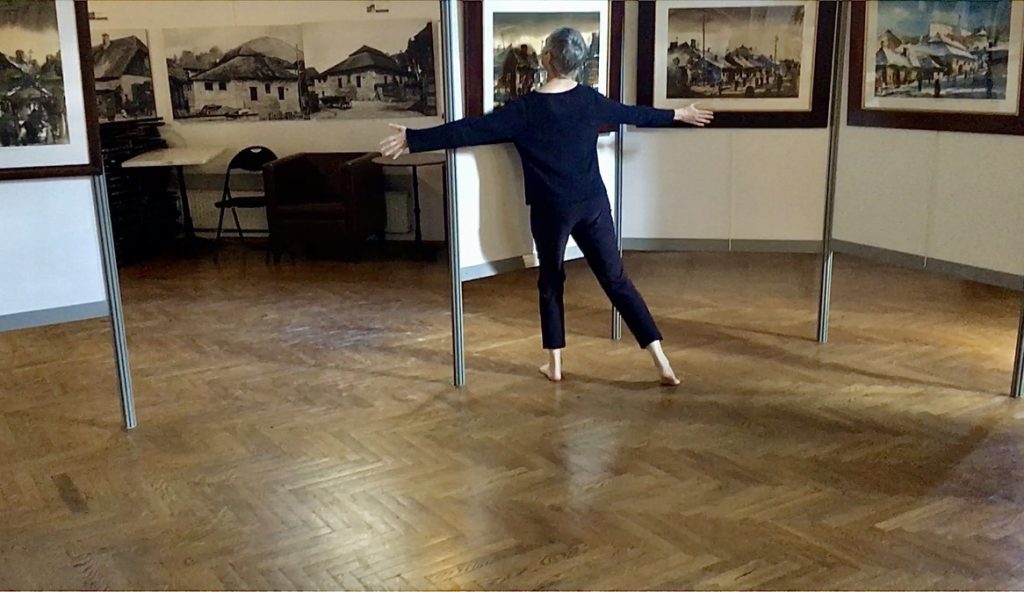
Karen Goodman in “Dybbuk Remix: Dancing Between Worlds” – Screenshot screenshot courtesy of the artist.
In Goodman’s film, Dybbuk Remix: Dancing Between Worlds, she explains how for years she studied the old Yiddish dances preserved on The Dybbuk so that she could learn and own them in her body. When she finally arrived in Poland to visit the museum that houses the archives she found that there it was the dances that possessed her. Goodman states “without plan” that she handed over her camera to someone else and danced.
One senses the effect that this particular history had on Goodman and though her movements are small, occasionally subtle and intimate, she appeared briefly transported to an earlier time to join her ancestors in their traditional dances. It is a journey I was honored to witness.
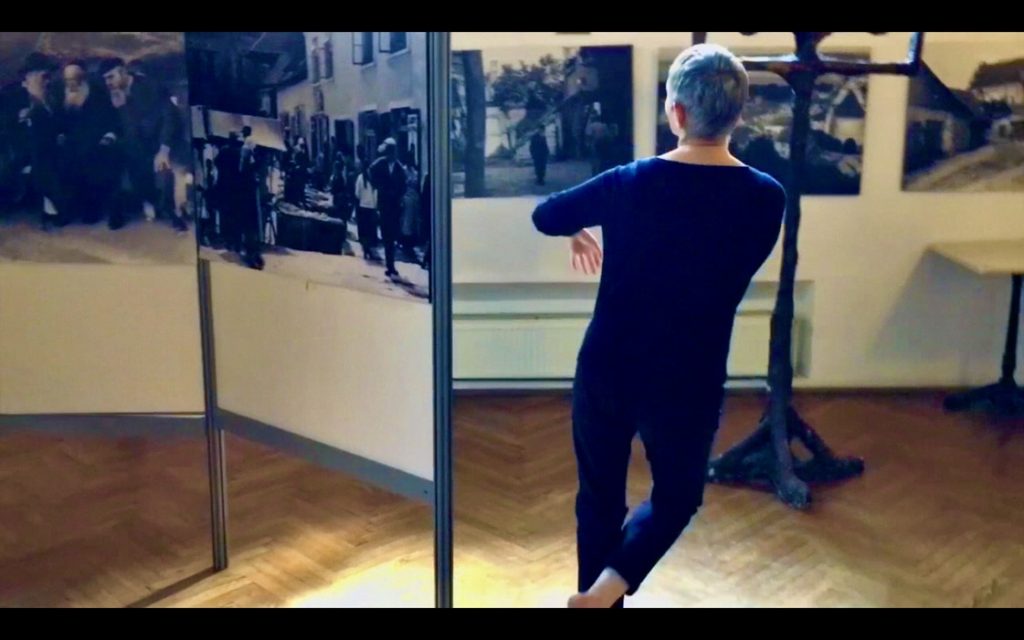
Screenshot from Karen Goodman’s film “Dybbuk Remix: Dancing Between Worlds” – courtesy of the artist.
I reached out to Goodman with a few questions. Here are her responses.
JS. Did you travel to Poland with the idea of making this film?
KG: Not at all! I went because my rabbi led a tour there and I’d never been. Because I’d been researching Yiddish folk dance for some years and writing about and had made a doc/instructional video in 2002 (“Come Let Us Dance”), as well as taking Yiddish language classes for many years, so I just thought I should go. Of course, no Jewish tour to Poland goes w/o visiting a death camp or 2, so that was part of it. But there has been a resurgence of Jewish interest within Poland and there are people who are part Jewish who didn’t know it or hid it intentionally. Now small synagogue groups have been formed, so we visited a couple of them. As I say in the film, we came to this town where 1930s Yiddish language films had been shot. It’s a beautiful place and was a resort town and it was so moving for me to be there and with the music playing and the photos, I was riveted and couldn’t leave. Just a few hours earlier, I’d been talking to a professor of religions at UCSB, Richard Hecht, who’d been to the same Jewish arts conference a few years before that I was at and he’d suggested we collaborate on a project for the next conference. I was sitting in the space unwilling to leave to go to lunch when I had the idea to dance there and to have him film me, which we did a few hours later after going to that cemetery and on a cruise on the Vistula.
JS: Regarding the music at the beginning of the film. Can you explain what “Ahavo Rabo” means?
KG: Ahavo Rabo, or in Hebrew spelled Ahava Raba means “great or abundant love” that God has. It also is a mode/scale of 9 notes that is one of several that is used in Jewish music.
JS: You state in the film that you handed over your camera and unplanned began to dance. The movement is so beautiful, simple and powerful. Was it all improvisation?
KG: Yes, the movement was completely improvised to what was playing in the space. I didn’t know those particular tunes, but I know Klezmer music and its general cadences. I just went with the music, just feeling it and being in that atmosphere, remembering the dances that I’d learned from “The Dybbuk” film and from a few people from whom I’ve learned some dances.
JS: Were the Jews forced out of this city during WWII by the Nazis and who built the wall of headstones?
KG: I don’t remember the details of if the Jews were rounded up or fled or both. I do remember that the space had been the town synagogue and the Nazis turned it into a stable. Much of it was rebuilt, but not returned to being a synagogue because there were no longer any Jews, so it too is a memorial.
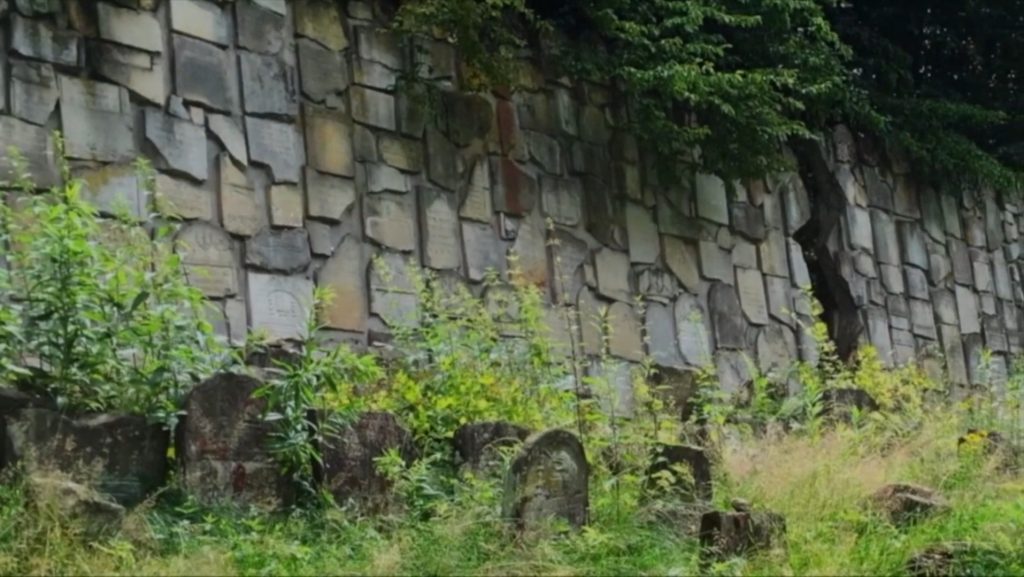
Memorial wall in Kazimierz Dolny, Poland – Scene from Karen Goodman’s film “Dybbuk Remix: Dancing Between Worlds” – Screenshot by LADC.
JS: Is the wall a memorial to those people?
KG: Yes, the wall is made up of the gravestones that had been vandalized but left there unmoored from their graves so there was no way to match them to the right grave. The wall is more recent, but I don’t know from when and yes, it is a memorial. I took the photos because it is such a moving work w/o thinking that I might use them. The whole film was put together afterwards by me just looking and looking at the small clips I had and the photos and over time seeing connections I could make. There’s maybe altogether not even 10 mins of dance clips and not all of it usable, so it was really made in editing. My editor, Lucinda Luvaas, is an excellent artist and a filmmaker and although I pretty much directed the structure and order, she added the color and using the 2 photos as gates and engineered so beautifully all the fades and superimpositions and other things that also made it look so good. The original film was one of the earliest to use superimpositions, so when we started working, I knew I wanted to keep that and for the same reason as the original for the mystery and connection of the other world with this world.
(Later research on my part reveals that on the wall referenced here is a plaque recalling the memory of 3000 Jews of Kazimierz Dolny murdered by the Germans.)
JS: What feelings were you left with after making this journey and the film.
KG: I’m glad that I was able to put something cogent together from those moments of what I think I can honestly call ecstatic dance in the sense of at once thinking/not thinking, “of remembering and imagining in the same instant, pressing ourselves into whatever is in this universe hoping only to feel it press back,” (I wrote and spoke this in my piece Close Dancing back c. 1999, but it expresses how I felt while dancing.) It’s that sense of being at one with this history, which is the history of, if not my family specifically, of their lives in general.
I worked on it 3 times over 5 years. It hadn’t felt finished. It took me 2 years to find out who the musicians were to license their music and get an mp3 so I didn’t have to use the sound my iPhone recorded with other ambient, extraneous sounds in it. That helps a lot to make it seem more planned. I changed the ending after showing it to a few more people and realizing I wanted to make it more of a ghost story and also to focus on what the original 1915 play is about, which is the porous border between life and death, the spirit and the living world. And the power of fate: in the story, when a vow before God is forgotten and then ignored, it leads to tragedy.
The last element I put in was Ahavo Rabo and the music by Michael Alpert. They are both from an album that Michael produced for a 2005 Stanford U. conference on S. An-sky and his expeditions. In the present moment, it’s interesting to know that the expeditions all took place in what is now Ukraine. Those wax cylinders were thought lost for decades from the time of the Russian revolution until the mid 1990s after the end of the Communist regime that they were brought out of hiding to the Vernadsky National Library of Ukraine. I just got the license from the library last December — only 2 months before the invasion!
I feel I was taken to a greater depth and understanding of Jewish ecstatic dance and of filmmaking. When you see me pressing myself against the photos, that’s because I really did want to be literally closer to my own grandparents’ background, which I knew so little about. Learning the dances and so much about what it felt like to grow up and live in that general kind of environment has been important to me. I grew up Jewish and have always identified as one and appreciate the rich culture that Jews have managed to create no matter how or where they have lived. This little film has been my chance to bring it all together as a granddaughter of immigrants, a modern dancer and Yiddish dance researcher. It’s a documentary of me encountering my history through art and its sibling, ritual.
#####
Dybbuk Remix: Dancing Between Worlds is streaming at Fusion International Film Festival website through December 17, 2022. You can access it by clicking HERE.
Dybbuk Remix: Dancing Between Worlds is also available on Vimeo at 99 cents for 72 hours! Or rent the film at Goodman’s website.
On this same site is information and clips of Goodman’s other film that she can distribute, “The Art of Benjamin Zemach.” It is another film at she studied for authentic Yiddish gesture.
To watch the trailer for Dybbuk Remix: Dancing Between Worlds, please click HERE.
Written by Jeff Slayton for LA Dance Chronicle.
Featured image: Screenshot from Karen Goodman’s “Dybbuk Remix: Dancing Between Worlds” – Courtesy of the artist.

